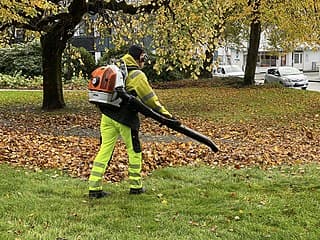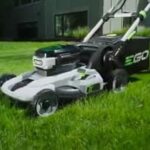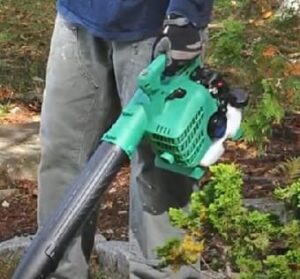As an Amazon Associate, this site earns commissions from qualifying purchases. For more information click here.
Anyone who has owned a leaf blower has at some point, faced this problem. If this is your first time to own and use one of these garden tools, it can be frustrating especially when you need to use it now. But no need to worry as most of the time, this problem can be fixed easily. Here are the top 10 reasons why your leaf blower will not start.
If your leaf blower won’t start, the fuel mix is probably incorrect, or it is too old and needs to be replaced. Other possible reasons are a worn out spark plug, clogged filters or broken starter spring.
Now that you know the major reasons why leaf blowers sometimes will not start, let us look deeper into each one and how to resolve the problem.
Blocked Air Filter
A clean air filter is essential so fuel and air can mix. A clogged filter makes this impossible and the engine will not run. Even if you get the blower to start it will eventually stall.
Solution. Air filters get clogged and dirty with use, so clean it regularly with a brush, soapy water or compressed air. This should be enough to keep the filter tidy. However if It is too dirty or you find yourself cleaning frequently, replace the air filter. Tip: you should also clean the muffler. This can also get clogged over time and may need cleaning. Give it a good brush and that should be enough.
This video shows how to clean a leaf blower air filter. Though there are many brands, the basic procedures are very similar. If you have a Mueller UltraStorm cordless leaf blower, this should work too.
Wrong Fuel Mix
There are two aspects to this. First, you have to make sure the fuel mixture ratio is correct. In most leaf blowers the gas and oil ratio is 40:1 or 50:1. Check your owner’s manual for more information on the proper mix.
But even if it is properly mixed, gas and oil can separate. If you have not used your leaf blower for a long time and the tank is filled, the gas and oil have come apart.
Solution. Close the fuel tank and give the blower a shake. This might be enough to combine the fuel again. If this does not work, add a new fuel mix. Keep in mind this only works on two-stroke engines. A four-stroke leaf blower does not need oil and gas mixing..
Related: How to Mix Gas for Leaf Blowers
Problems with the Spark Arrestor
The spark arrestor keeps leaf blowers from producing sparks. Due to heavy use, the spark arrestor screen can get dirty. If this occurs your leaf blower will not start. The arrestor could also be damaged if your blower has been under heavy use or it could be worn out.
Even if you are careful with your blower, these parts eventually get worn out. Figuring this out early is the best way to prevent damage so regular checkups or maintenance is ideal.
Solution. Turn off the blower and remove the spark arrestor. Clean it with a brush and put it back. Try the blower again to see if it works now. How quickly this takes depends on how dirty the spark arrestor is. If your blower is rarely used, cleaning will suffice. But consider replacing the spark arrestor if it is very dirty or shows signs of damage.
Damaged Recoil Starter
Most blowers have a rope that enables the spring to recoil after you pull the cord. If the spring breaks, the cord will not rewind and you will not be able to start the engine. Without the spring there is no way for the cord to pull to the pulley. What this means is the engine will have trouble starting.
Solution. The only solution here is to replace the spring, though in some instances it might be better to get a new recoil starter. Check the operating instructions also for additional details.
Blocked Carburetor
If you leave unused fuel in the tank for a long time, it turns viscous. This can spread into other parts including the carburetor, causing all kinds of engine problems. This can be prevented by replacing the fuel every 30 days.
Solution. If the carburetor is covered in oil sludge, clean it off. If this does not work, rebuild the carburetor. But if you are not comfortable dismantling it (then assembling it again), replace the carburetor with a new one. This is why it is important to replace the fuel every month. Doing that will save you the trouble of cleaning, rebuilding or replacing the carburetor.
The process will vary from blower to blower so you should check the manual or official website for instructions. A well-made carburetor will last a long time so you don’t have to worry about a a replacement anytime soon. But if your blower is already old or heavily used, a replacement is better than cleaning.
The replacement has to be compatible with the model. The XFEEFWAJ carburetor kit for instance, is designed for the Echo PB-580 PB-580T.
Old Fuel in the Tank
Do not store gas in the blower tank for more than 30 days. After a month, the gas will slowly turn into a thick sludge. If you only use your blower in the fall and keep it in storage for the rest of the year, this will definitely occur and the engine will refuse to start.
Solution. Remove the old fuel and clean the tank. Pour new fuel and make sure the mix ratio is correct. You should also replace fuel every 30 days. Keep the tank empty if you are going to store it for several weeks or months.
No Power Source
This applies to corded (electric) and cordless (battery powered) leaf blowers. In both cases the problem likely has something to do with the power source.
Solution. If you are using an electric blower , make sure the cord is plugged in and not worn out. You should also check the on/off switch.
If your leaf blower is battery powered, look into the charge. Is it full? When charging, does the battery actually gain power? If it does not, the battery or charger might be damaged. In this case you have to take the leaf blower to an expert for examination.
Worn Out Spark Plug
Spark plugs get dirty over regular use, and after a while it gets worn out. It could also come loose or parts of it could break apart. How you resolve this depends on the problem.
Solution. Inspect the spark plug to determine what is wrong. If it is just dirty, a thorough cleaning will be enough. You can also put the spark plug back into place if it came loose. But if there is a lot of carbon buildup or bunt electrodes, it is time for a replacement.
If you are not sure, use a spark plug tester. With this you will be able to tell if the component is just dirty or broken. Having one of these can be handy if you go through a lot of spark plugs on your blower.
Not Priming the Pump
All gas leaf blowers need to have the pump primed up. There is no exact number for this but 5-6 times is about the average. If the pump is working, the leaf blower should start when you pull the pump.
Solution. If you primed the pump and the engine does not start, there could be a problem with the carburetor or filters. You should also check the operating instructions as startup procedures can vary among manufacturers.
Clogged Fuel Filter
This is another component that can get clogged by dirt or old, viscous fuel. This is one of the areas you should check right away and fortunately it is also one of the easier ones to fix.
Solution. The best option is to replace the fuel filter. Cleaning may help but it will be a temporary fix. Over time fuel filters get clogged and it is more practical to get a new one. You can prevent this from happening by replacing old fuel. As long as you do not let gasoline sit in the tank for months the filter should be fine.

How to Keep Leaf Blower in Good Condition
Once you have fixed the problem, keep the following tips in mind so your leaf blower will run smoothly. These apply to gas powered models only.
- Always use fresh gas. If the fuel is more than a month old, replace it. Adding a fuel stabilizer can help.
- Clean the fuel and air filters regularly. Replace them when they get too dirty.
- Inspect the fuel lines and replace them if there are cracks. If the fuel lines are working fine but the fuel does not pass through, clean the fuel filter.
- Use your leaf blower only as directed in the instructions. Do not leave your leaf blower out in the rain or snow.

I love the outdoors and all the tools for maintaining gardens, yards and lawns. The only thing I am more passionate about is sharing what I know about garden and outdoor equipment.


